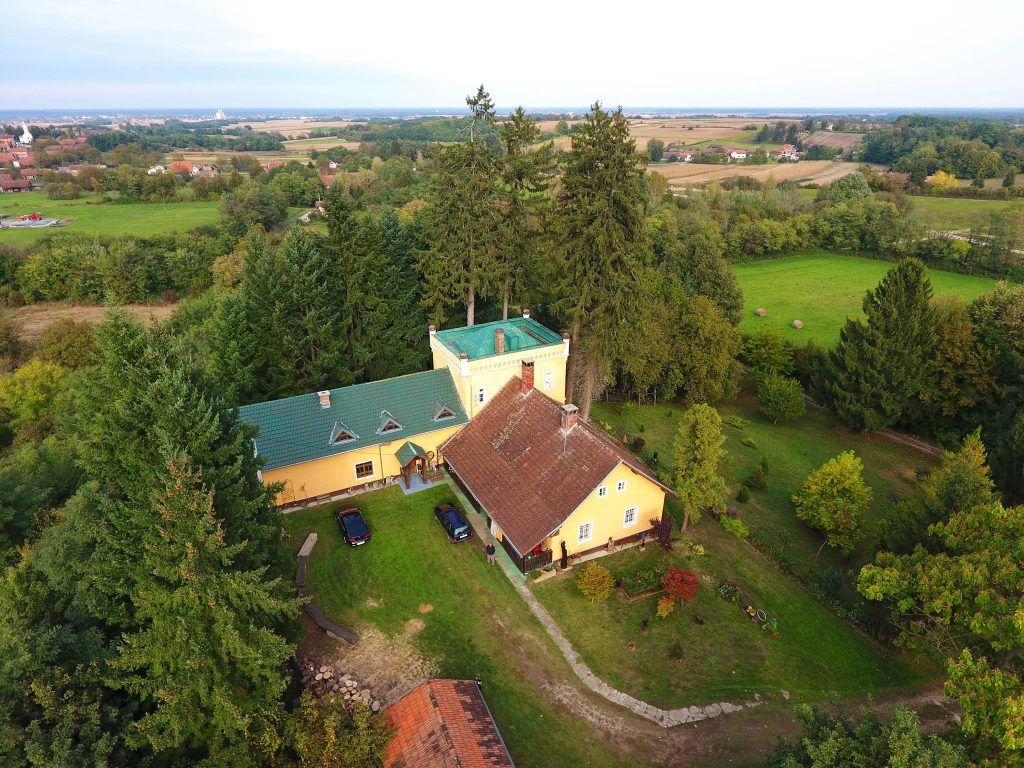BARNAGOR – THE PLACE WHERE NATURE, HISTORY, CULTURE AND ART LIVE IN PERFECT HARMONY
If you dream of being in a beautiful, isolated, quiet and countryside idyllic spot, BARNAGOR is undoubtedly the perfect destination for you. In addition to the beauty of this eye-catching manor positioned on a hilltop, it offers enough variety for you to explore over several days – from historical, through a special story of a noble family, to features of various artistic styles that decorate this building. Here, dwelling in perfect harmony you can find respected works of renowned artists from naive to contemporary, modern art styles: paintings, sculptures, photographs and installations, numerous books and publications in multiple languages, unavoidable poetry which pervades this environment to the glimpse into the Austro – Hungarians history of Đurđevačka Podravina. All this and much, much more, can be experienced at Barnagor.
On the slopes of Čepelovac, in the immediate vicinity of the town Đurđevac in the Koprivnica – Križevci County, originally conceived as a country courtyard for the family of Petar von Trezić, Commander of the Austro – Hungarian Army, stands the manor, Milin Marindvor, as noted in land registers, built in 1867. The next generation of owners renamed it to Barnagor, a name it still holds today, as high ground overlooking the brook Barna. The noble family was left without income and without an heir, so the manor was evidently deteriorating, and it would certainly have been demolished if a woman, who saw its potential and former splendour, the writer Božica Jelušić, hadn’t appeared. We believe that the original owner would not have wanted his former home to be owned by a better person.
Only with Božica’s intrinsic determination and imagination, alone and with her own funds and endless will, effort and perseverance, this “Inland Titanic”, as ironically labelled by Božica’s father, was given a new chance to rise in an even more glittering shine. Unique in Podravina, but also in the greater region – from Orahovica, up to Strigova, it is the only traditional building restored with the owner’s own funds, and with the help and cordiality of just friends and dear people who share the enthusiasm of the current owner.
Only someone like me could take something like this in their hands, quite similar to the globe where only vague outlines, holograms that are insufficient for reconstruction can be seen, yet maybe challenging enough even for the rest of your life … All self-made, with effort, long delays, probable failures, ambiguities, nervousness, and despair. I am not theirs, I do not want to build them a museum, I rebelled spitefully, but the trap had already been shackled around … is how Božica describes her life’s adventure in the novel “Cleaning the Globe”, which reconstructs the family chronicle and pays tribute to the family. Something like aeulogy to the dead so they may rest in peace, and then, unburdened she can tell her own story about Barnagor.
And, her story, on the other hand, is truly unique and special, which still continues with the help of her family, especially daughter Ivana, to develop through numerous events she organizes at the estate, enriching the cultural offer of Čepelovac, Đurđevac and the entire region. Her actions often remind of the work of Sisyphus, persistently rolling the immense boulder of culture up the hill of misunderstanding and very often, ignorance.
With short interruptions, the restoration of Barnagor lasted for about twenty years. It took a lot of personal discipline and a concrete vision to persevere for so long in following a path that no one recognized or understood. After so much time, the interior of the Manor, the carpentry, the sanitary facilities, the roof, and the facade were refurbished. In the end, the neglected, unattractive farm buildings were turned into a pleasant, cosy atelier with a small gallery, Ars Barnagor. It hosts thematic exhibitions, art workshops, summer creative workshops, intimate concerts, book presentations, and visitors can enjoy pictures, sculptures, souvenirs and books of various authors throughout the year. Ars Barnagor gathers authors and visitors through their now-traditional festivals. In the spring Barnagor hosts the Park of Roosters Colony, an open-air workshop, with the invited sculptors working in the Barnagor Park and shaping an exhibition-horticultural space. The following is the marking of Earth Day, where visitors can participate in interesting clay workshops held by affirmed mentors. There is also Barnagor’s Day that is celebrated every year in the last week of June with its SOS Fair of Things Left Behind, when guests refreshed with beer, a beverage or coffee, enjoy nature, and take home a heart full of experiences and hand full of interesting souvenirs, at very favourable prices. Magical autumn is reserved for Barnafest – Barnagor’s Oktoberfest with beer, sausages, entertainment and outdoor music!
The environment surrounding Barnagor with plenty of space, trees, numerous plants, massive wooden forest stairs, a theatre in the woods, flowers, maple trees and the future plateau of native trees, an orchard of old autochthonous varieties, colourful and lush gardens, Park of Roosters and numerous artistic details is where nature and art are glorified by both the body and soul, where everything falls into its own place and makes sense. Far from triviality, noise, and the hustle and bustle of everyday life, a silent and pleasant nest has been created, where birds entertain you, and even a small forest dweller may come to eat from your hands.
Take a peek inside Barnagor
Salons connected together into a little labyrinth lead us to the ground floor. Here you will find a cabinet with a valuable library of more than 4,000 books, the oldest exemplar from the year 1808, a massive writing desk and a chamber dominated by a well preserved original tiled stove, which once spread warmth to this building. In the corner are two carefully restored wardrobes that stylishly depictnot only the period from which they come, but also reveal the taste of former owners and interior decorating during the Austro-Hungarian period. The walls are adorned with valuable works by countless renowned painters, who fit perfectly despite the thematically dividing time gap. The guest room is connected with the kitchen and reflects the spirit of the present owners. We continue through a passage leading to solid oak stairs that lead to the first floor.
A small library welcomes us in the lobby, whose valuable content attracts attention. Here the weekly magazines of the time such as “Zurguten” and “Stunde Gartenlaube”, which came to Đurđevac every week from Vienna!, are bound into a collection of annual editions. It is unbelievable how much the von Trezić family appreciated reading even at an elder age when, due to limited mobility, they sent their workers from the estate to fetch their copy of newspapers and magazines. The library’s unique feature is the fact that most of the books are printed in gothic, which is no longer taught today, not even in German schools, and which today’s owner is familiar with. Here we have read an interesting story published in “Podravac” in 1900. Namely, a precious gemstone was found on the estate of von Trezić, Barnagor. An opal, estimated at the then 60 forints, weighing 40 carats. The gemstone was found in the brook Barna that flows through Trezić’s estate. It was appraised by a professor of mineralogy in Budapest, and has since disappeared without a trace.
From the library, we enter the so-called hunting room, which once served as a bedroom. Here all the motifs from paintings, furniture and other details reflect nature and hunting. The refurbished table and chairs come from Hungary, and are accompanied by a majestic matching dresser. As part of the inventory, a concert piano from Vienna, “Czapka & Sohn” dating back to 1880 proudly stands, the very one that received a silver medal for quality at the Vienna permanent exhibition of art. Its richer and more expensive sibling is kept at the European House in Zagreb, and at the same exhibition received a gold medal. The restoration of such instrument is extremely expensive, so it stands here as an interesting museum exhibit, awaiting for better times to come.
Then we go to the tower with a panoramic view at all four sides, where from a height the beauty of this picturesque landscape can be captured, inhaling fresh air and listening to the many sounds blended into a symphony of Barnagor’s feathery, winged and furry inhabitants. Going down the stairs we enjoy the interesting figurine exhibits that stand as decorations and silently follow our footsteps.
Filled with impressions, inspired by the open-hearted creative atmosphere, we conclude that Barnagor is an ideal destination for people of taste and all who value the culture of both the past and present times.
Text: Elizabeta Milanović Glavica

